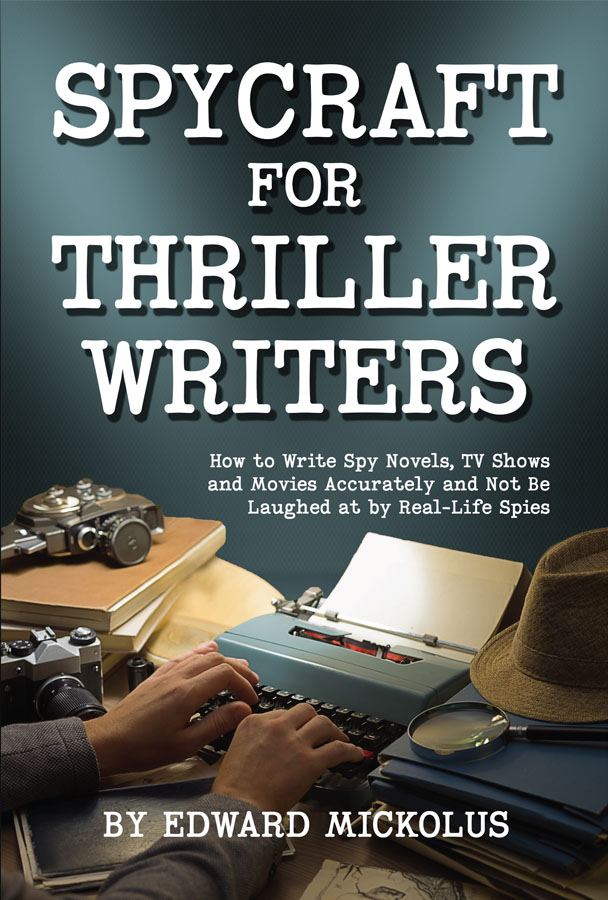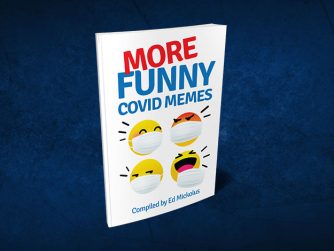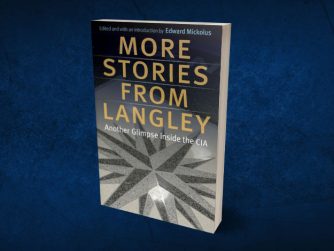WHY WRITERS NEED THIS BOOK!
Much of what the public believes it understands about espionage in general and the CIA in particular, and anything in between, comes from spy fiction (spy-fi): novels, television series, and movies.
Sometimes the writers get it right. More often, they do not, to the detriment of the public’s understanding of what intelligence officers do for our country, the development of misimpressions at home and overseas of the missions and operations of these organizations, and a winnowing of the number of talented people who would otherwise consider a career in intelligence.
Intelligence is one of the world’s oldest professions, and possibly the most misunderstood. This book will give you tips on how intelligence officers go about their work, what some of our arcane language means, and what they are like.
It will point out common myths, and suggest how you can avoid perpetuating their more deleterious effects on your credibility and their public images.
This book covers the types of material that the author (retired CIA) and his colleagues frequently see in fictional writing about espionage, and will lead you away from some of the more common glaring errors.
It will give you just what you need to provide an accurate flavor of where intel officers work, what they do, how they sound, how they think, and what motivates them.
You can improve the accuracy of your writing and eliminate unintentionally irritating slurs against American patriots by paying careful attention to these observations.
- Title : Spycraft for Thriller Writers: How to Write Spy Novels, TV Shows and Movies Accurately and Not Be Laughed at by Real-Life Spies
- Author : Edward Mickolus
- Publisher : Wandering Woods Publishers
- Publication Date : January 27, 2021
- Language : English
- Paperback : 118 pages
- ISBN-10 : 1949173062
- ISBN-13 : 978-1949173062
- Item Weight : 6.1 ounces
- Dimensions : 6 x 0.27 x 9 inches

Reviews
“If you want your writing (or speaking) about the CIA to be taken seriously, read and heed Ed Mickolus “no-nonsense” advice, Spycraft for Thriller Writers. This is that teacher you may not have loved in the classroom but years later recognize as “the best.” Do you think, “if I told you I’d have to kill you” is clever? No, it’s a cliche and a stupid one at that. How about “eliminated with extreme prejudice.” Use that phrase and your book deserves to be in the 25 cent bin. Mickolus’ readable style packs hundreds of helpful hints and accurate terminology for spy writing aside often humorous “never do’s” to produce a needed resource for intelligence writers. Also a delightful introduction to espionage vocabulary for the general reader, Spycraft for Thriller Writers deserves to be on your built-in and electronic bookshelves.” – Robert Wallace
“This book is a much-needed dose of sanity about the CIA and the intelligence community. It is a gift to thriller writers and the public alike. I had respected a major thriller writer until I read a book of his that touched on CIA and another intelligence agency. It shattered my faith in his research and credibility. With this book, a writer can be plausible while maintaining the confidence of even an informed readership.” – Amazon review
“If you aspire to be a credible writer of spy fiction, then you need to buy Ed’s book. Otherwise, your stories may sound more like Austin Powers without the intent of being a wacky comedy.” – Amazon review
Book review: For aspiring thriller writers, lessons in credibility, Jacksonville Florida Times-Union USA TODAY NETWORK, March 21, 2021
Reviewed in MenSana, June 2021, p. 4: “should help the aspiring spy novelist put out a yarn that will not drive current employees of the CIA crazy. No, they don’t send a hit squad to ‘terminate you with extreme prejudice,’ but the cover of your book might be pinned to a dart board in a break room by actual darts. He begins with a quick sketch of the 16 agencies in the Intelligence Community. The meat of the book is the chapter about the CIA, its structure and operations. He reminds us that the CIA is a civil service organization, with practically no swashbuckling, although some in the agency have died in the line of duty. He gives us a tour of the parts of the CIA available to civilians, with some good pictures. A chapter on errors to avoid should keep the aspiring novelist from making them. There’s a spy-movie/TV trivia quiz, a bibliography, and a bit about the author. I always prefer an index in a nonfiction book, but it’s short, and sticky notes are cheap. The book is amply supplied with good-quality photographs. My only quibble with the author is his referring to Emma Peel in The Avengers, played by the glorious Diana Rigg, as a ‘sidekick.’ If you want to write a thriller, you might do well to acquire this book.”
Reviewed in CIA Retirees Association Quarterly vol. XLVI, no. 1, Spring 2021, p. 15.
Reviewed in Calliope, the newsletter of the Writers Special Interest Group of Mensa, Fall 2021, p. 43.
Mensa Bulletin November/December 2021, p. 24.
TABLE OF CONTENTS
- Introduction
- The Intelligence Community’s Member Organizations: Logos, Locations, Missions
- Getting to Know the CIA
- A Visit to CIA Headquarters
- Common Errors and How to Avoid Them
- Spy-Fi Trivia
- Further Reading
- About the Author
INTRODUCTION
Much of what the public believes it understands about espionage in general and the CIA in particular, and anything in between, comes from spy fiction (spy-fi): novels, television series, and movies. Sometimes the writers get it right. More often, they do not, to the detriment of the public’s understanding of what intelligence officers do for our country, the development of misimpressions at home and overseas of the missions and operations of these organizations, and a winnowing of the number of talented people who would otherwise consider a career in intelligence. Intelligence is one of the world’s oldest professions, and possibly the most misunderstood.
When I joined the U.S. Central Intelligence Agency more than 40 years ago, television and movies had been in a golden age of spy-fi. James Bond reigned supreme, but a host of other notional spies skulked solidly behind him. We thrilled to the exploits of such heroes as Napoleon Solo and Illya Kuriakin (The Man from U.N.C.L.E.), the team from Mission Impossible (since reduced in the movie series to Tom Cruise’s Ethan Hunt character and his supporting cast), Matt Helm, Derek Flint, Modesty Blaise, Honey West, James West and Artemus Gordon, The Prisoner, Kelly Robinson and Alexander Scott.
Later years brought us the other JBs—Jack Bauer and Jason Bourne and the almost-JB Jack Ryan—plus Austin Powers, Johnny English, Chuck, and Archer. The role of women has advanced from the at-best sidekicks of Emma Peel and Agent 99 to Carrie Mathison, Sidney Bristow, Annie Walker, Nikita, Salt, Lorraine Broughton, and Elizabeth Jennings. Many of these characters grew from novels.
Spies in novels and on screen often are portrayed as clever and amoral assassins, sometimes going rogue to do battle with bureaucracies that have metastasized into evil versions of their real-world models. They often are loners, jetting off to far-flung countries at a moment’s notice, with no developed “backstopping” of their cover identities. Often they simply announce themselves in their true names, and expect the bad guys to know who they are and that they have met their match. They often have intriguing gadgets, be it an Aston Martin DB-5, the Man from U.N.C.L.E.’s multi-version gun, or Maxwell Smart’s various Cones of Silence. Their enemies frequently capture them, then subject them and/or their associates to physical and mental tortures, but ultimately blab away the details of their nefarious plans and reveal the fatal flaw. The good guys always figure things out in time and save the world, with a maximum of quips, gunfire, explosions, and sex.
Although the primary focus of spy-fi, as well as my career, was on the Central Intelligence Agency (CIA), I have included discussion of the rest of the Intelligence Community (IC), including their locations (so that you don’t have your protagonist simply walking across the street from one agency to another), photos of their headquarters buildings, principal seals/logos, and their mission(s) within the Executive Branch. I have included a more extensive treatment of the Federal Bureau of Investigation (FBI), where I taught tradecraft and which seems to have a spy-fi focus second only to that of CIA.
This volume will give you tips on how we go about our work, what some of our arcane language means, and what we are like. It will point out common myths, and suggest how you can avoid perpetuating their more deleterious effects on your credibility and our public images.
Working on the assumption that I have not cornered the market on insights into this topic, I conferred with hundreds of members of the Intelligence Community, many of whom preferred to not be named, some of whom have worked with spy-fi authors who sometimes chose to incorporate their counsel, sometimes did not. Thanks to them—they know who they are and you don’t have to—along with Lanie D’Alessandro, Beth Barns, Bill Barrett, Stephanie Bellistri, Mark Benbow, Darrell Blocker, Diana Bolsinger, Kip Brailey, Andrea Hattler Bramson, Thomas Leo Briggs, Terry Joseph Busch, Kevin Callahan, Gary Carroll, Leo Chambliss, Clint Collins, Nicholas Dujmovic, Robert Eatinger, Ron Estes, Rodney Faraon, Lia Fidas, Bob Flores, Dennis Gleeson, Anne Gruner, Jay Grusin, John Hedley, Courtney Runion Hunt, Elinor Houghton Kelly, Martha Neff Kessler, Phil Lago, Darryl Lansey, Spencer Lee, Irma Lopez, Clint Mesle, Chan Mohney, John Nolton, Jon Nowick, Mary O’Sullivan, Hugh Pettis, Robert Phillipson, Will Rogers, Ross Stapleton-Gray, Janet Stiegler, Michael Sulick, Gerhardt Thamm, Kathleen Bardzell Thomas, Mike Toth, Bo Tumasz, Tom Weber, Raymond Wong, Debra Yamanaka, and Donna Zerbato. You’ll find their insights sprinkled throughout these pages. I have, however, cornered the market on errors in this book.
This book is not designed to be a comprehensive primer on how to conduct intelligence collection and covert action operations, perform analysis, provide intelligence to customers, or run the organizations. There are other sources you can consult, including the organizations’ websites and many books in the Further Reading section at the end of this volume.
I am not going to expose sensitive clandestine sources and methods here. Rather, this book covers the types of material that my colleagues and I frequently see in fictional writing about espionage, and will lead you away from some of the more common glaring errors. It will give you just what you need to provide an accurate flavor of where we work, what we do, how we sound, how we think, and what motivates us. You can improve the accuracy of your writing and eliminate unintentionally irritating slurs against American patriots by paying careful attention to these observations.







